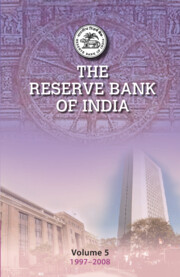Book contents
- Frontmatter
- Contents
- Tables
- Boxes
- Foreword
- Preface
- Acknowledgements
- List of Abbreviations
- 1 Introduction: Managing Liberalisation
- 2 The Macroeconomic Context
- 3 Monetary Management
- 4 Foreign Exchange Market and Management of the Capital Account
- 5 Foreign Exchange Reserves Management
- 6 Financial Markets
- 7 Public Debt Management
- 8 The Payment and Settlement Systems
- 9 Currency Management
- 10 Regulation of the Financial System – Part I: Commercial Banks
- 10 Regulation of the Financial System Part II: Other Financial Institutions
- 11 Supervision of the Financial System
- 12 Rural Credit
- 13 Financial Inclusion
- 14 Communication Policy
- 15 Organisational Change
- Appendices
- Photographs
- Select Bibliography
- Index
12 - Rural Credit
Published online by Cambridge University Press: 10 January 2023
- Frontmatter
- Contents
- Tables
- Boxes
- Foreword
- Preface
- Acknowledgements
- List of Abbreviations
- 1 Introduction: Managing Liberalisation
- 2 The Macroeconomic Context
- 3 Monetary Management
- 4 Foreign Exchange Market and Management of the Capital Account
- 5 Foreign Exchange Reserves Management
- 6 Financial Markets
- 7 Public Debt Management
- 8 The Payment and Settlement Systems
- 9 Currency Management
- 10 Regulation of the Financial System – Part I: Commercial Banks
- 10 Regulation of the Financial System Part II: Other Financial Institutions
- 11 Supervision of the Financial System
- 12 Rural Credit
- 13 Financial Inclusion
- 14 Communication Policy
- 15 Organisational Change
- Appendices
- Photographs
- Select Bibliography
- Index
Summary
Introduction
The preamble to the Reserve Bank of India (RBI) Act enjoins the Bank to operate the credit system to the advantage of the country, a country where most of the population lives in rural areas. Further, the Bank is required to ‘study various aspects of rural credit and development’ as it may consider necessary to do so for promoting integrated rural development. From the 1970s, this aim was achieved by means of directed credit, mainly ‘priority sector lending’. The policy directed banks to lend to agriculture, small enterprises, retail trade, microcredit, education and housing, subject to certain conditions. It started with nationalised banks in 1974 and was extended to private banks in 1978. In 1985, 40 per cent of bank credit was directed to flow to priority sectors, within which 25 per cent (10 per cent of the total advances) was to go to the ‘weaker sections’ of society. Weaker sections included small and marginal farmers with landholdings of less than 5 acres, landless labourers, artisans and ‘tiny’ enterprises with loan limits up to 50,000, beneficiaries of the government’s poverty alleviation programmes, Scheduled Caste/Scheduled Tribe (SC/ST) borrowers and members of self-help groups (SHGs). A separate sub-target of 16 per cent was fixed for agriculture in 1985 and raised to 18 per cent in 1990.
The financial sector reforms from 1992 underscored that banks and other financial institutions (FIs) had to become strong and efficient (see Chapter 10.1). The report of the Committee on the Financial System (Narasimham Committee I, 1991) recommended that the directed credit programme, being an anomaly in a ‘free market competitive system’, should be phased out. The Committee on Banking Sector Reforms (Narasimham Committee II, 1998) observed that ‘a high incidence of NPAs [non-performing assets or advances] could be traced to policies of directed credit’. Other reviews also recommended reforms and scaling down. But neither the government nor the Reserve Bank was ready to deprioritise the priority sector.
Still, as more emphasis was laid on operational freedom and profitability of banks, the Reserve Bank was under pressure to pause or go soft on directed lending and its rural focus. While it avoided a reversal of its policies, occasional wavering in its resolve could be observed.
- Type
- Chapter
- Information
- The Reserve Bank of IndiaVolume 5, 1997–2008, pp. 523 - 558Publisher: Cambridge University PressPrint publication year: 2023



